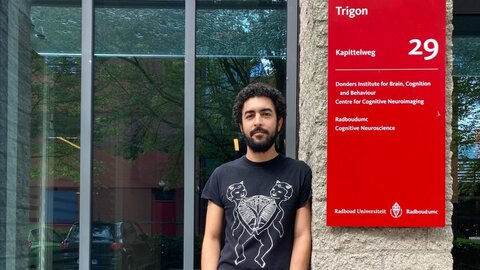Research in the land of (un)limited opportunities

Depending on where an auditory cue comes from, the pinna or auricle changes the sound spectrum before the cue reaches the eardrum. Since the shape of a pinna is highly individual – even more so than a finger print – it also affects the spectral cue in a very individual manner. In order to produce realistic auditory perception artificially, this individuality needs to be reflected as precisely as possible. That is why my Schrödinger project was about finding electrophysiological measures of how realistic a virtual sound source is perceived to be. Since artificial sources are mainly perceived inside the head, investigating these spectral cues also served to study the following behavioural phenomenon: sound cues approaching the listener at a steady loudness are perceived more intensely than those, with all other sound properties being identical, that are receding from the listener.
An Eldorado for hearing research
The Hearing Research Center of Boston University groups about 20 faculty members from different departments and is closely linked to various labs of Harvard Medical School and the Massachusetts Institute of Technology. In order to be able to gather research experience in this environment I already started to prepare for it during my PhD project at my home institution, the Acoustics Research Institute of the Austrian Academy of Sciences. Once I arrived in Boston, I initially had to prove myself but then enjoyed intense, fruitful and personal working relationships. Internal structures were marked here and there by a surprisingly hierarchical organisation. The lab and office spaces were of amazing diversity, covering the whole spectrum from tiny, dusty-filled windowless rooms to state-of-the-art office premises with a great view over the city.
Insights into the life of young Americans
Rents in Boston are steep, very steep, which is why hardly anyone under 30 can afford their own apartment. Hence, a two-storey wooden house in Cambridge Port was home not only to five genuine Americans but also to my wife, myself, and our poodle. My wife found it a bit hard to get started in the US, since she had to wait three months for her work permit, which you can apply for only once you have an American residence. The obstacles were compensated by the fact that the somewhat crowded living arrangements very quickly resulted in close friendships which made everyday life more agreeable. We went on trips together and were treated to great hospitality, being invited to family occasions where the mandatory roast turkey was served. Something I found regrettable, however, was the way people handle alcohol. Much too often there are cases of alcohol abuse on the sly as a way of countering the pervasive pressure to achieve.
Life after Boston
The vibrant research environment in Boston of course attracts many young international researchers. This diversity is incredibly enriching in terms of scientific and cultural exchanges and provided me with networking opportunities not only in my host institution, but also at other research facilities and companies. Thanks to the return-phase part of the grant, which offers transitional prospects, I was able to maintain these networks and some joint research ideas and follow up on them. The year in Boston was greatly enriching for all concerned, both professionally and personally. My heartfelt thanks go to Piotr Majdak for the excellent support during preparations, to Barbara Shinn-Cunningham and H. Steven Colburn for the great support in Boston – and last but not least to the Austrian Science Fund FWF for the funding and the exemplary organisation!





